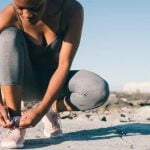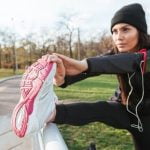Strong and toned legs are essential for overall fitness and athletic performance, making muscle and fitness legs exercises a crucial component of any workout routine. The lower body muscles, including the quadriceps, hamstrings, glutes, and calves, play a significant role in daily activities and sports. By incorporating targeted leg exercises into your regimen, you can improve muscle strength, enhance calorie burning during workouts, and boost lower body endurance.
Not only do legs exercises contribute to a more sculpted physique, but they also offer numerous benefits beyond aesthetics. Strengthening your leg muscles can increase overall stability and balance, reduce the risk of injury during physical activities or sports, and support better posture. Additionally, focusing on lower body workouts can help to improve your performance in other areas of fitness such as running, jumping, or weightlifting.
There are various types of legs exercises that target different muscle groups in the lower body. From classic movements like squats and lunges to compound exercises like deadlifts and leg presses, each exercise offers unique benefits for muscle development and strength.
When performed with proper form and technique, these exercises can help you achieve greater results while minimizing the risk of injury. In the following sections, we will explore different legs exercises, provide guidance on technique execution, share a sample workout routine for your lower body muscles, address common mistakes to avoid, offer tips for progression in your workouts, and stress the importance of rest and recovery for optimal muscle growth.
Benefits of Incorporating Legs Exercises Into Your Workout Routine
The benefits of incorporating leg exercises into your workout routine are vast and crucial for achieving overall fitness goals. Strong and toned legs are not only important for aesthetic purposes but also play a significant role in enhancing athletic performance and promoting functional movement.
One key advantage of focusing on leg workouts is the potential for muscle development. The legs consist of some of the largest muscle groups in the body, including the quadriceps, hamstrings, calves, and glutes. By incorporating exercises like squats, lunges, and deadlifts into your routine, you can effectively target these muscles and stimulate growth, leading to increased strength and definition in your lower body.
Additionally, leg exercises are highly effective for burning calories and promoting weight loss. Given the size of the muscles involved in leg workouts, they require a significant amount of energy to perform. This results in a higher calorie burn compared to other exercises, making leg workouts an excellent choice for individuals looking to shed excess fat and improve their overall body composition.
| Advantages | Benefits |
|---|---|
| Muscle Development | Increased strength and definition |
| Calorie Burning | Promotes weight loss |
Different Types of Legs Exercises
When it comes to building strong and toned legs, incorporating a variety of exercises into your workout routine is key. Different types of leg exercises target various muscles in the lower body, helping you achieve a well-rounded and balanced physique. Some of the most effective legs exercises include squats, lunges, deadlifts, and leg presses.
Squats
Squats are often considered the king of all leg exercises as they work multiple muscle groups simultaneously. They primarily target the quadriceps, hamstrings, glutes, and lower back. Proper squat form is essential to prevent injury and maximize results. Remember to keep your chest up, back straight, and knees in line with your toes while performing squats.
Lunges
Lunges are another excellent legs exercise that helps build strength and stability in the lower body. They mainly target the quads, hamstrings, glutes, and calves. Lunges can be performed forward or backward and with or without weights for added resistance. Make sure to keep your front knee at a 90-degree angle and avoid letting it extend past your toes during this exercise.
Deadlifts
Deadlifts are a great compound exercise that targets the hamstrings, glutes, lower back, and core muscles. This exercise not only strengthens the muscles in the legs but also improves overall posture and stability. When performing deadlifts, maintain a neutral spine position throughout the movement and engage your core for added support. Be sure to use proper lifting technique to avoid any strain on your lower back.
Leg Presses
Leg presses are a popular machine-based exercise that isolates the quads, hamstrings, and glutes. This exercise is beneficial for those looking to increase muscle mass in the legs while minimizing stress on other parts of the body like the lower back. Adjust the seat position on the leg press machine according to your comfort level and ensure that your knees are not locked out when extending your legs during this exercise.
Proper Form and Technique
When performing squats, it is essential to keep your feet shoulder-width apart and lower yourself down as if you were sitting back into a chair. Make sure your knees do not extend past your toes to avoid any potential knee injury.
Additionally, when doing lunges, focus on taking a large step forward or backward while keeping your torso upright and lowering yourself until both knees are at 90-degree angles. Proper alignment is key in preventing any strain on the knees or hips during this exercise.
For deadlifts, be sure to hinge at the hips while keeping your chest up and shoulders back. Engage your glutes and hamstrings as you lift the weight up, ensuring that you are not rounding your back in the process.
When using machines like leg presses, adjust the seat position so that your knees are at 90-degree angles when pushing the weight away from you. By following these detailed instructions for proper form and technique in each legs exercise, you can reduce the risk of injury and maximize muscle engagement for better results over time.
Sample Legs Workout Routine
When it comes to achieving overall muscle and fitness legs exercises, incorporating a well-rounded workout routine that targets the lower body is essential. Strong and toned legs not only contribute to athletic performance but also play a crucial role in everyday activities. By focusing on legs exercises, you can develop muscle strength, burn calories, and improve your balance and stability.
One of the most effective ways to target the muscles in your legs is by including a variety of exercises in your workout routine. Exercises like squats, lunges, deadlifts, and leg presses work different muscle groups within the legs, including the quadriceps, hamstrings, glutes, and calves. This variety helps ensure that all areas of your lower body are engaged and strengthened.
In addition to targeting specific muscle groups, incorporating compound movements into your legs workouts can help improve overall coordination and functional strength. Compound exercises like squats and deadlifts not only work multiple muscles at once but also mimic natural movement patterns, making them beneficial for both muscle growth and overall fitness. Mixing these compound movements with isolation exercises can create a well-balanced legs workout routine for optimal results.
| Benefit | Detail |
|---|---|
| Muscle Development | Legs exercises such as squats and lunges help in building muscle mass in the lower body. |
| Calorie Burning | Engaging large muscle groups in legs workouts can aid in burning more calories during exercise. |
| Lower Body Strength | Focusing on leg exercises improves strength in key lower body muscles like quads, hamstrings, and glutes. |
Common Mistakes to Avoid
When it comes to working out our legs, there are common mistakes that many people tend to make that can hinder progress and potentially lead to injuries. One of the most prevalent mistakes is using improper form and technique while performing legs exercises.
This can not only reduce the effectiveness of the exercise but also put unnecessary strain on joints and muscles. To avoid this, it is important to focus on maintaining proper posture, alignment, and range of motion during each movement.
Another mistake to watch out for is overloading with too much weight. While challenging yourself is crucial for muscle growth and strength gains, using weights that are too heavy can compromise form and increase the risk of injury. It is essential to start with a manageable weight and gradually increase as you build strength. Remember, quality over quantity when it comes to lifting weights for legs exercises.
Additionally, neglecting the importance of warm-up and cooldown routines before and after legs workouts is a common mistake that many individuals make. Skipping these crucial steps can lead to muscle stiffness, decreased flexibility, and an increased likelihood of muscle strains or tears.
To prevent this, incorporate dynamic stretches like leg swings or hip openers before your workout, and static stretches like hamstring stretches or calf stretches after your workout to help improve flexibility and reduce muscle soreness. Remember, taking care of your body before and after your leg workouts is just as important as the exercises themselves for overall muscle health and fitness.
Tips for Progressing and Advancing Your Legs Workouts
When it comes to building strong and toned legs, it’s essential to continuously challenge yourself and progress in your workouts. By incorporating strategies to increase the intensity of your legs exercises over time, you can continue to see improvements in muscle strength and endurance. Here are some tips to help you advance your legs workouts effectively:
- Gradually Increase Weight: One way to progress in your legs exercises is by gradually increasing the weight you’re lifting. Whether you’re doing squats, lunges, or leg presses, adding more resistance will help stimulate muscle growth and enhance strength. Make sure to choose weights that are challenging but still allow you to maintain proper form.
- Try Different Variations: To keep your muscles guessing and prevent plateaus, incorporate different variations of leg exercises into your routine. For example, switch up between front squats and back squats or include single-leg movements like Bulgarian split squats or single-leg deadlifts. This variation will target different muscle fibers and promote overall leg development.
- Implement Progressive Overload: Progressive overload is a key principle in strength training that involves gradually increasing the stress placed on the muscles over time. This can be achieved by adding more sets, reps, or weight to your legs exercises as you become stronger. By consistently challenging your muscles and pushing past your limits, you’ll see continuous improvements in muscle growth and endurance.
By incorporating these strategies into your legs workout routine, you can effectively progress and advance towards achieving stronger and more defined leg muscles. Remember to listen to your body, adjust the intensity of your workouts as needed, and prioritize proper nutrition and rest for optimal recovery and growth. Consistency and dedication are key in building muscular legs that not only look great but also support overall fitness performance.
The Importance of Rest and Recovery
In conclusion, incorporating legs exercises into your workout routine is crucial for overall muscle and fitness development. Strong and toned legs not only improve athletic performance but also enhance daily activities and overall health. By focusing on exercises like squats, lunges, deadlifts, and leg presses, you can target different muscles in your legs for a well-rounded lower body workout.
Proper form and technique are essential when performing legs exercises to prevent injury and maximize results. It’s important to pay attention to your body positioning and alignment during each exercise to effectively engage the targeted muscles. By following a sample legs workout routine and avoiding common mistakes, you can make significant progress in building muscle strength and endurance in your lower body.
As you advance in your legs workouts, it’s crucial to progress gradually by increasing the intensity of your exercises over time. This will help continue challenging your leg muscles for growth and development. However, equally important is allowing your leg muscles to rest and recover in between workouts.
Resting allows for muscle repair and growth, preventing overtraining injuries that can set back your fitness goals. Remember that balance is key when it comes to achieving optimal muscle and fitness levels through legs exercises.
Frequently Asked Questions
What Is a Good Workout Routine for Legs?
A good workout routine for legs typically includes a combination of strength training exercises like squats, lunges, deadlifts, and calf raises. It’s important to target different muscle groups in the legs to build overall strength and definition.
What Is the Best Exercise to Build Leg Muscles?
Squats are widely regarded as one of the best exercises to build leg muscles. They target multiple muscle groups in the legs, including the quads, hamstrings, and glutes. Incorporating squats into your workout routine can help improve overall leg strength and size.
Is 4 Exercises Enough for Legs?
Whether 4 exercises are enough for legs depends on various factors such as individual fitness goals, level of intensity, and frequency of workouts. For some individuals, incorporating 4 effective exercises targeting different leg muscles may be sufficient for a well-rounded leg workout routine.
However, it’s important to ensure that each exercise is performed with proper form and intensity to maximize results.

Passionate about providing useful information to anyone with an interest in the field of Personal Training, I strive to pass on to our readers quality information and to answer any questions about Personal Trainers, the work they do and how to become one.





